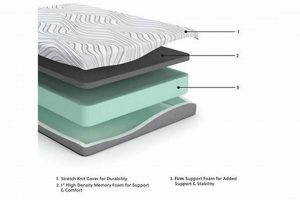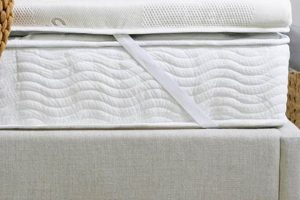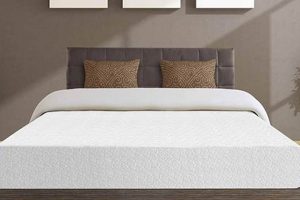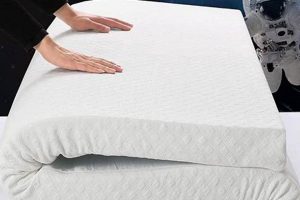A cushioning layer designed to be placed atop a mattress, typically constructed from viscoelastic foam and measuring four inches in thickness, can significantly alter the feel of a sleep surface. The material conforms to the body’s contours, distributing weight and reducing pressure points. This type of bedding accessory is commonly used to enhance comfort or extend the life of an existing mattress.
The utilization of such a product can offer enhanced spinal alignment, leading to a reduction in back pain for some individuals. The conforming properties of the foam can also isolate motion, making it suitable for couples. Historically, the development of this product stems from NASA’s research into energy-absorbing materials, adapted for consumer use to improve sleep quality and overall comfort. The density and composition of the foam directly impact its durability and performance.
This article will further delve into the composition, density variations, intended uses, and practical considerations when selecting an appropriate sleep surface enhancement of this type. Subsequent sections will address factors such as breathability, cleaning and maintenance, and common misconceptions regarding its effectiveness for various sleep-related issues.
Guidance on Viscoelastic Bedding Overlays
The selection and utilization of a four-inch viscoelastic foam layer for mattress enhancement requires careful consideration to ensure optimal performance and longevity. The following points provide guidance for maximizing the benefits of such a product.
Tip 1: Density Assessment: Prioritize a higher density rating. Increased density correlates directly with enhanced support, greater durability, and reduced risk of premature sagging or compression over time. Consult product specifications for accurate density figures.
Tip 2: Ventilation Features: Opt for designs incorporating ventilation channels or open-cell structures. These features promote airflow and mitigate heat retention, contributing to a cooler and more comfortable sleep environment. Evaluate the breathability of the foam composition before purchase.
Tip 3: Mattress Compatibility: Evaluate the existing mattress condition. While a four-inch viscoelastic layer can improve comfort, it will not compensate for a severely damaged or structurally unsound underlying mattress. Address significant mattress issues before investing in an overlay.
Tip 4: Proper Support Framework: Verify that the bed frame and support system can adequately accommodate the combined weight of the mattress, the viscoelastic layer, and the occupants. Insufficient support can compromise the layer’s performance and lifespan.
Tip 5: Protection and Maintenance: Utilize a waterproof mattress protector specifically designed to encase both the mattress and the viscoelastic layer. This safeguards against spills, stains, and dust mites, extending the product’s usable life. Adhere to manufacturer’s cleaning instructions.
Tip 6: Off-Gassing Considerations: Be aware of potential initial off-gassing odors common with viscoelastic foam products. Allow adequate ventilation in the room for several days after unpacking to dissipate any residual odors. Verify certifications regarding volatile organic compound (VOC) emissions.
Tip 7: Trial Period Evaluation: Take advantage of any trial periods offered by the retailer. A sufficient trial period allows for thorough assessment of the product’s comfort and suitability before committing to a final purchase. Evaluate the impact on sleep quality and any potential alleviation of discomfort.
Proper selection and maintenance of a four-inch viscoelastic foam mattress enhancement can lead to improved sleep comfort and potentially alleviate certain pressure-related discomforts. However, realistic expectations and adherence to recommended practices are crucial for maximizing its benefits.
The subsequent section will address potential drawbacks and limitations, as well as alternative bedding solutions for specific needs and preferences.
1. Density (pounds per cubic foot)
The density of a four-inch viscoelastic foam mattress overlay, measured in pounds per cubic foot (lbs/ft), directly correlates with its performance and longevity. Density quantifies the mass of the foam material packed into a given volume. A higher density indicates a greater amount of foam material present, leading to increased support and resistance to compression. For example, a four-inch overlay with a density of 5 lbs/ft will generally offer superior support and durability compared to one with a density of 3 lbs/ft. The former resists sagging and retains its shape more effectively over time, while the latter is more prone to developing impressions and losing its supportive properties under sustained weight. This distinction is critical for users seeking long-term comfort and pressure relief.
The practical significance of understanding foam density lies in its impact on both comfort and cost-effectiveness. While overlays with lower density may offer a lower initial purchase price, their reduced lifespan and diminished support often result in a shorter period of usefulness, ultimately increasing the long-term cost. Conversely, investing in a higher density four-inch overlay can provide consistent support and comfort for an extended period, representing a more economical choice despite the higher upfront investment. Furthermore, the ability of a higher-density overlay to maintain its shape and supportive properties directly impacts spinal alignment and pressure point reduction, contributing to improved sleep quality and potentially mitigating back pain. For instance, an individual weighing 200 lbs might find a 5 lbs/ft density overlay provides adequate support, whereas a lighter individual might find even a 4 lbs/ft density sufficient, demonstrating the interplay between body weight and foam density needs.
In summary, the density rating of a four-inch viscoelastic foam mattress overlay is a primary determinant of its supportive capabilities, durability, and overall value. While specific density requirements vary depending on individual needs and preferences, understanding the relationship between density and performance is crucial for making an informed purchasing decision. Challenges remain in accurately assessing density without physical examination, highlighting the importance of relying on verifiable product specifications and established brand reputations when selecting a viscoelastic foam mattress overlay. This understanding links directly to the broader theme of optimizing sleep comfort and overall well-being through informed bedding choices.
2. Thickness Uniformity
Thickness uniformity in a four-inch viscoelastic foam mattress overlay is a critical parameter directly influencing its overall perfor
mance and user satisfaction. Deviation from the specified four-inch thickness, even by a small margin, can create inconsistent support and pressure distribution across the sleep surface. Such non-uniformity might arise from manufacturing defects, inconsistencies in foam density, or improper compression during packaging and storage. For instance, if one section of the overlay measures only 3.5 inches while another reaches 4.5 inches, the sleeper will experience differential support, potentially leading to spinal misalignment and localized pressure points. This is particularly impactful for side sleepers who rely on consistent cushioning to maintain proper spinal curvature. The structural integrity of the “4 in memory foam mattress topper” depends significantly on thickness uniformity.
The practical significance of ensuring thickness uniformity extends to the longevity and durability of the viscoelastic foam layer. Areas with reduced thickness are more susceptible to premature wear and compression, resulting in uneven surfaces and compromised support over time. Consider a scenario where a specific section of the overlay consistently experiences higher compression due to concentrated weight distribution. This repeated compression in a thinner area leads to accelerated degradation of the foam structure, creating a permanent indentation that negatively impacts sleep quality and compromises the overlay’s ability to provide consistent support. Manufacturers often employ quality control measures, including laser scanning and automated thickness gauging, to mitigate thickness variations and ensure compliance with specified tolerances.
In conclusion, maintaining thickness uniformity in a four-inch viscoelastic foam mattress overlay is essential for consistent support, pressure distribution, and long-term durability. While minor variations may be unavoidable due to manufacturing processes, significant deviations can compromise the overlay’s performance and negatively impact sleep quality. Assessing thickness uniformity visually and through physical inspection, along with relying on reputable brands known for stringent quality control, are essential steps in selecting a suitable viscoelastic foam mattress overlay. The challenge remains in developing affordable and reliable methods for consumers to independently verify thickness uniformity prior to purchase. This aspect is fundamental to optimizing sleep comfort and overall well-being, underscoring the importance of informed bedding choices.
3. Certifications (e.g., CertiPUR-US)
Certifications, such as CertiPUR-US, provide independent verification of the composition and characteristics of viscoelastic foam used in products like a four-inch mattress overlay. These certifications establish limits on the presence of potentially harmful substances, including certain flame retardants, heavy metals, formaldehyde, and phthalates. The absence of such certification implies a lack of independent validation regarding the materials used in the foam, increasing the risk of exposure to undesirable chemicals. For instance, a CertiPUR-US certified four-inch memory foam layer signifies that the foam has been tested and meets specific criteria related to low volatile organic compound (VOC) emissions, contributing to better indoor air quality and reduced potential for adverse health effects. Conversely, an uncertified product may contain higher levels of VOCs, potentially leading to off-gassing odors and respiratory irritation.
The practical significance of considering certifications when purchasing a four-inch viscoelastic foam mattress overlay lies in the ability to make an informed decision based on verifiable evidence. Certification programs require manufacturers to undergo regular testing and auditing processes, ensuring ongoing compliance with established standards. This provides consumers with a degree of confidence regarding the product’s safety and environmental impact. As an example, a consumer with chemical sensitivities might prioritize purchasing a CertiPUR-US certified overlay to minimize potential exposure to allergens or irritants. Furthermore, some certifications extend beyond chemical content to address durability and performance aspects of the foam, providing additional assurance of product quality. An absence of third-party certification places the onus on the consumer to independently assess the product’s composition and potential risks, a task that is often challenging due to the complexity of foam manufacturing processes.
In conclusion, certifications like CertiPUR-US serve as a critical indicator of the safety and quality of viscoelastic foam used in a four-inch mattress overlay. These certifications provide independent verification of material composition and emissions, enabling consumers to make informed choices and minimize potential health risks. While certification alone does not guarantee complete absence of all potential hazards, it represents a significant step towards ensuring product safety and environmental responsibility. Challenges persist in consistently enforcing certification standards and expanding their scope to encompass a broader range of potential concerns. This ongoing effort contributes directly to improving sleep comfort and overall well-being through informed bedding choices.
4. Heat dissipation
Heat dissipation is a critical factor influencing the comfort and overall effectiveness of a four-inch viscoelastic foam mattress overlay. Due to the inherent properties of viscoelastic foam, which tends to retain heat, the ability of an overlay to dissipate heat effectively is paramount for maintaining a comfortable sleep temperature. Failure to adequately address heat accumulation can lead to discomfort, disrupted sleep patterns, and a perceived reduction in the product’s overall value.
- Foam Density and Airflow
Higher density viscoelastic foam, while offering enhanced support and durability, generally exhibits reduced airflow compared to lower density foams. This restriction in airflow impedes the natural dissipation of body heat, leading to a warmer sleep environment. Manufacturers often address this issue by incorporating open-cell foam structures or ventilation channels to promote air circulation within the overlay.
- Material Composition and Thermal Conductivity
The specific composition of the viscoelastic foam influences its thermal conductivity, which dictates how readily heat is transferred through the material. Some foams are infused with gel particles or other materials designed to enhance thermal conductivity and facilitate heat dissipation. These additives work by absorbing body heat and conducting it away from the sleeper’s body, creating a cooler sleep surface.
- Cover Fabric and Breathability
The type of fabric used to cover the four-inch viscoelastic foam mattress overlay plays a significant role in heat dissipation. Breathable fabrics, such as cotton or bamboo-derived materials, allow for greater airflow and moisture wicking, promoting a cooler and drier sleep environment. Conversely, synthetic fabrics with lower breathability can trap heat and moisture, exacerbating the issue of heat retention.
- Ambient Temperature and Humidity
External environmental factors, such as ambient temperature and humidity levels, also influence the effectiveness of heat dissipation. In warmer climates or during periods of high hum
idity, the challenge of dissipating heat from a viscoelastic foam overlay is amplified. Strategies such as using air conditioning or dehumidifiers can help mitigate the impact of external factors on sleep temperature.
Effective heat dissipation in a four-inch viscoelastic foam mattress overlay is a multifaceted challenge requiring careful consideration of foam density, material composition, cover fabric breathability, and ambient environmental conditions. Innovations in foam technology and fabric design continue to address this issue, aiming to provide a cooler and more comfortable sleep experience. Selecting an overlay with features specifically designed to enhance heat dissipation is crucial for individuals prone to overheating during sleep. Understanding the interplay of these factors enables consumers to make informed decisions that optimize their sleep environment and overall well-being.
5. Motion isolation
Motion isolation, a critical characteristic of a four-inch viscoelastic foam mattress overlay, refers to its capacity to absorb and dampen movement, preventing its transmission across the sleep surface. This attribute is particularly valuable for individuals sharing a bed, as it minimizes disturbances caused by a partner’s tossing, turning, or getting in and out of bed. The effectiveness of motion isolation is directly linked to the density and composition of the viscoelastic foam. Higher-density foam, with its increased mass and structural integrity, generally exhibits superior motion isolation compared to lower-density alternatives. The conforming properties of the foam also contribute to this effect, as it conforms to the body’s contours and absorbs movement locally rather than allowing it to propagate across the surface. For instance, if one individual shifts their position, the four-inch viscoelastic foam layer compresses and contours to their new shape, absorbing the associated motion energy and preventing it from significantly impacting the other individual’s sleep.
The practical significance of motion isolation in a four-inch viscoelastic foam mattress overlay becomes evident in scenarios involving varying sleep schedules or differing levels of sleep sensitivity between partners. Consider a situation where one partner works a late-night shift and frequently enters and exits the bed at irregular hours. Without adequate motion isolation, these movements are likely to awaken or disturb the other partner, leading to fragmented sleep and reduced overall sleep quality. A four-inch viscoelastic foam overlay with excellent motion isolation can mitigate these disturbances, allowing both individuals to maintain uninterrupted sleep cycles. The degree of motion isolation required is also dependent on individual sensitivity and the intensity of movements. Someone who is a light sleeper will need maximum motion isolation, while a heavy sleeper can tolerate a little more motion transfer.
In conclusion, motion isolation is a key attribute of a four-inch viscoelastic foam mattress overlay, directly impacting the sleep quality of individuals sharing a bed. Its effectiveness is determined by the foam’s density, composition, and conforming properties. While assessing motion isolation can be subjective, consumers can rely on product specifications, reviews, and trial periods to evaluate its suitability for their specific needs. A continued challenge lies in developing objective, standardized metrics for quantifying motion isolation performance across different viscoelastic foam products. Enhancing motion isolation through innovative foam technologies and designs remains a critical area of focus for improving sleep comfort and minimizing sleep disturbances.
6. Support characteristics
Support characteristics are paramount when evaluating the suitability of a four-inch viscoelastic foam mattress overlay. These characteristics determine how effectively the overlay maintains spinal alignment, distributes pressure, and contributes to overall sleep comfort. The interplay between the overlay’s material properties and the individual’s body weight and sleep position dictates the degree of support provided.
- Density and Load-Bearing Capacity
The density of the viscoelastic foam directly influences its load-bearing capacity. Higher density foam exhibits greater resistance to compression, providing enhanced support for heavier individuals or those who prefer a firmer sleep surface. Conversely, lower density foam compresses more readily, offering a softer feel but potentially compromising support for individuals with higher body weights. The selection of an appropriate density is crucial for maintaining spinal alignment and preventing excessive sinking into the overlay, which can lead to discomfort and back pain.
- Indentation Load Deflection (ILD)
Indentation Load Deflection (ILD) measures the firmness of the viscoelastic foam. A higher ILD rating indicates a firmer surface, while a lower ILD rating indicates a softer surface. The ideal ILD rating is dependent on individual preferences and sleep position. Side sleepers typically benefit from a softer overlay with a lower ILD to allow the shoulders and hips to sink in, promoting spinal alignment. Back sleepers often prefer a firmer overlay with a higher ILD to prevent excessive sinking and maintain proper lumbar support. Stomach sleepers generally require the firmest support to prevent arching of the back.
- Zoning and Targeted Support
Some four-inch viscoelastic foam overlays incorporate zoning, which involves varying the density or ILD of the foam in different areas to provide targeted support to specific regions of the body. For example, an overlay might feature firmer support in the lumbar region to promote spinal alignment and softer support in the shoulder region to alleviate pressure points. This zoning approach allows for customized support tailored to individual needs and sleep positions, optimizing comfort and minimizing pressure-related discomfort.
- Compatibility with Underlying Mattress
The support characteristics of the four-inch viscoelastic foam overlay must be considered in conjunction with the support characteristics of the underlying mattress. An overlay cannot compensate for a severely sagging or unsupportive mattress. In such cases, the overlay will conform to the contours of the underlying mattress, potentially exacerbating alignment issues. Ideally, the underlying mattress should provide a stable and supportive foundation for the overlay to function effectively. Furthermore, the combined thickness of the mattress and overlay should be considered to ensure proper bed height and ease of getting in and out of bed.
The support characteristics of a four-inch viscoelastic foam mattress overlay represent a critical determinant of its overall performance and suitability. Careful consideration of foam density, ILD rating, zoning, and compatibility with the underlying mattress is essential for selecting an overlay that effectively promotes spinal alignment, distributes pressure, and enhances sleep comfort. The challenge remains in providing consumers with clear and objective metrics for evaluating these support characteristics and making informed purchasing decisions tailored to their individual needs.
Frequently Asked Questions
The following questions and answers address common inquiries regarding four-inch viscoelastic foam matt
ress overlays, providing detailed information on their use, maintenance, and potential benefits.
Question 1: How does the density of a four-inch viscoelastic foam mattress overlay affect its performance?
Density, measured in pounds per cubic foot, directly impacts the overlay’s support, durability, and resistance to compression. Higher densities provide enhanced support and longevity, while lower densities offer a softer feel but may degrade more quickly.
Question 2: What is the significance of CertiPUR-US certification for a four-inch viscoelastic foam mattress overlay?
CertiPUR-US certification indicates that the foam has been independently tested and meets specific standards for content, emissions, and durability, ensuring that it is free from harmful substances and meets requirements for low VOC emissions.
Question 3: How does a four-inch viscoelastic foam mattress overlay contribute to motion isolation?
The viscoelastic foam’s conforming properties absorb and dampen movement, minimizing its transmission across the sleep surface. This is particularly beneficial for couples, as it reduces disturbances caused by a partner’s movements.
Question 4: What considerations are necessary when selecting a four-inch viscoelastic foam mattress overlay to mitigate heat retention?
Opt for overlays incorporating ventilation channels or open-cell structures to promote airflow. Additionally, consider models with gel infusions or breathable cover fabrics to enhance heat dissipation and maintain a comfortable sleep temperature.
Question 5: How should a four-inch viscoelastic foam mattress overlay be properly cleaned and maintained?
Spot clean stains with a mild detergent and water solution. Avoid saturating the foam. Regular vacuuming can help remove dust and debris. It is advisable to use a waterproof mattress protector to prevent spills and stains from penetrating the foam.
Question 6: Can a four-inch viscoelastic foam mattress overlay correct a severely sagging or unsupportive mattress?
While an overlay can enhance comfort, it cannot fully compensate for a significantly damaged or structurally unsound underlying mattress. Addressing substantial mattress issues is recommended before investing in an overlay.
In summary, understanding the properties, certifications, and maintenance requirements of a four-inch viscoelastic foam mattress overlay is essential for maximizing its benefits and ensuring long-term satisfaction.
The next section will present potential alternative bedding solutions based on individual needs and preferences.
Concluding Remarks on 4 in Memory Foam Mattress Topper
This exploration of the “4 in memory foam mattress topper” has illuminated its key properties, benefits, and considerations for optimal utilization. From density’s influence on support and longevity to the significance of certifications in ensuring material safety, a comprehensive understanding is paramount for informed purchasing decisions. The analysis has further extended to crucial factors such as heat dissipation, motion isolation, and the complex interplay between the overlay and the underlying mattress. Thorough assessment of these elements is crucial for maximizing the potential advantages of this bedding accessory.
The effectiveness of a “4 in memory foam mattress topper” remains contingent on individual needs and preferences. Prior to procurement, careful evaluation of existing sleep surface deficiencies, desired comfort levels, and specific health considerations is strongly advised. With judicious selection and appropriate care, this bedding component can substantially improve sleep quality and overall well-being.


![Best Memory Foam King Size Mattress [Guide & Reviews] Organic & Natural Mattress Buyer’s Guide: Non-Toxic Sleep Solutions Best Memory Foam King Size Mattress [Guide & Reviews] | Organic & Natural Mattress Buyer’s Guide: Non-Toxic Sleep Solutions](https://mattressworldpa.com/wp-content/uploads/2025/07/th-3977-300x200.jpg)




